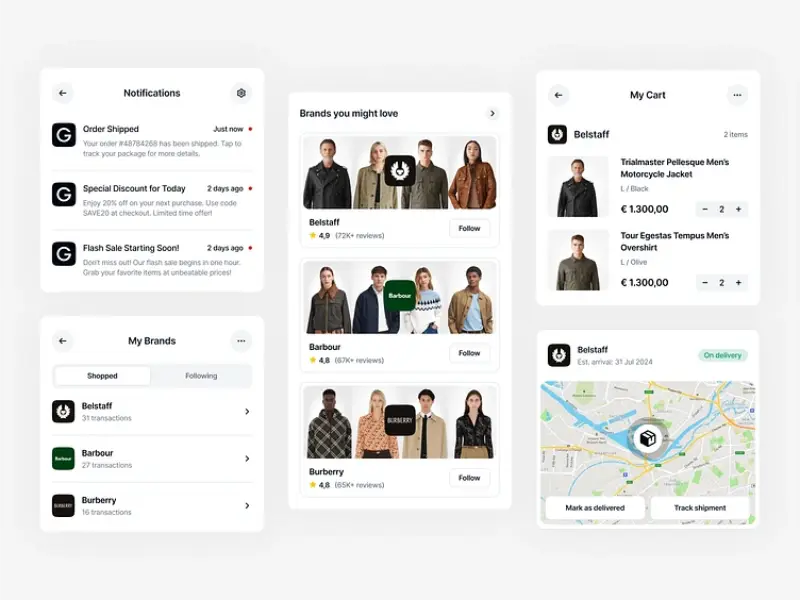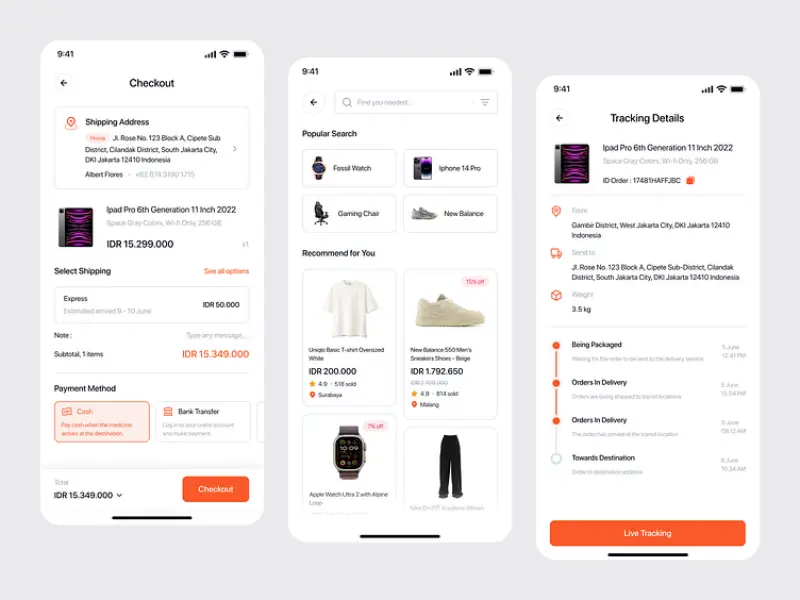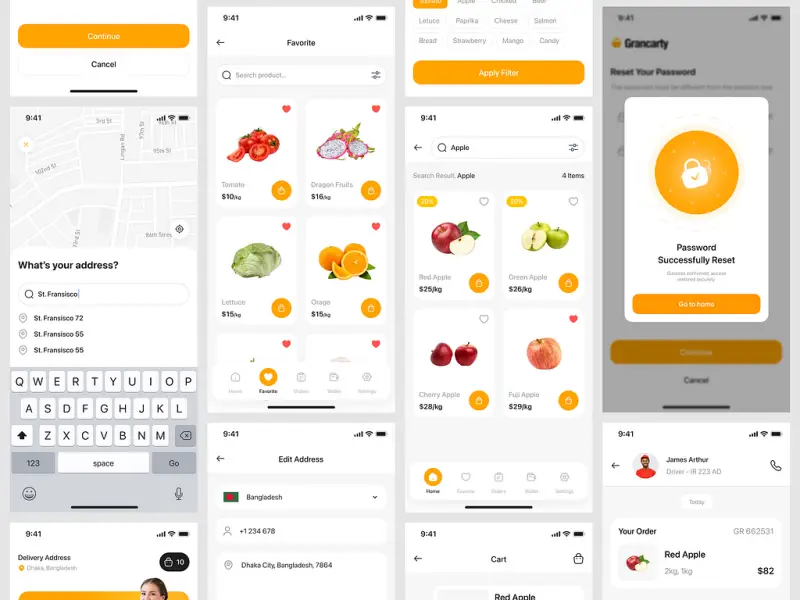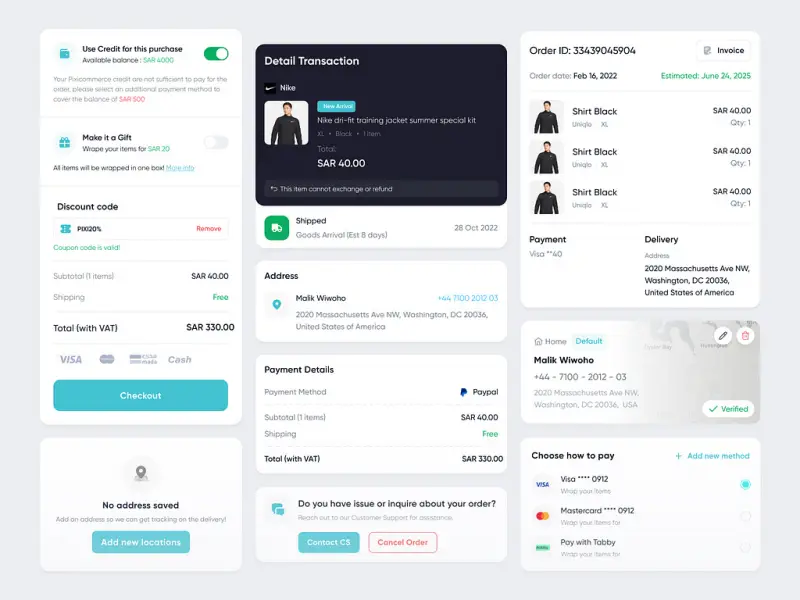Retail App Development Guide You Can’t Ignore in 2025
More and more people are shopping online with their mobile devices. This shift in consumer behavior is reshaping the retail industry, making retail app development a critical factor for businesses to stay competitive. Businesses that invest in mobile apps are setting themselves up for success by improving how they connect with customers. Experts predict global retail sales will keep growing over the next few years, and having a retail app could help your business stand out.
But how do you actually create a retail app that meets your business needs? In this guide, we’ll walk you through everything you need to know, from the must-have features and development process to the estimated costs and the best tech stacks to bring your app to life.
I. The Retail App Market: A Competitive Landscape
The retail app market is booming, with countless businesses vying for consumer attention. In such a dynamic and competitive space, retail app development must focus on creating exceptional experiences that keep users coming back. Shoppers today demand convenience, speed, and personalization, and meeting these expectations is no longer optional.
Retail application development
Trends show that digital interaction is fast becoming the primary way consumers engage with brands, underscoring the importance of retail app development for success. This means that developing a high-quality, user-centric retail app is no longer just a way to stay ahead of the curve—it’s a critical factor for retail success.
Consider this: according to recent data from eMarketer, mobile commerce (m-commerce) is projected to account for a jaw-dropping 72.9% of all e-commerce sales by 2024. This statistic underscores a major shift in consumer behavior. People are increasingly turning to their mobile devices for shopping because of the ease and flexibility they offer.
For retailers, the message is clear: to stay competitive and relevant, you need a sound retail mobile app development strategy to create an app that doesn’t just meet expectations—it exceeds them. A well-designed app can do more than just facilitate transactions; it can create an engaging, seamless shopping experience that builds loyalty and drives growth.
More Retail and eCommerce Industry-related Insights:
II. Types of Retail Apps On The Market
Retail apps come in many forms, each designed to meet specific shopping needs and appeal to different audiences. Understanding the various types of retail apps is essential for businesses looking to create one that aligns with their goals and delivers value to their customers. Below is an overview of the most common types of retail apps and how they operate:
1. E-Commerce Apps
E-commerce apps are digital stores that allow businesses to sell products directly to customers. These apps are like virtual versions of brick-and-mortar shops, offering a wide range of products across different categories. Their main goal is to provide a smooth and convenient shopping experience, often featuring:
- Detailed product descriptions
- High-quality images
- Customer reviews
- Easy navigation and checkout
Examples:
- Amazon: Amazon offers an extensive catalog of products, from electronics to groceries, and includes personalized recommendations, product comparisons, and user reviews.
- eBay: eBay allows users to buy and sell items through auctions or direct sales. Its app makes it easy to browse, bid, and purchase products from a global marketplace.
2. Marketplace Apps
Marketplace apps connect multiple vendors with buyers, offering a platform where users can compare prices, read reviews, and make informed purchases. These apps are popular because they provide a wide variety of products from different sellers in one place. Features often include:
-
Seller ratings and reviews
-
Feedback systems for transparency
-
Easy product comparisons
Examples:
- Etsy: Etsy focuses on handmade and vintage items, connecting small business owners and artisans with customers looking for unique products.
- Alibaba: Alibaba is a global wholesale marketplace that links businesses to suppliers for bulk purchases, showcasing the scalability of marketplace apps.
3. Loyalty and Rewards Apps
Loyalty and rewards apps are designed to engage customers by offering perks like discounts, points, or personalized deals. These apps incentivize repeat purchases, helping businesses build long-term relationships with their customers. Common features include:
- Points-based rewards systems
- Membership tiers with exclusive benefits
- Personalized product recommendations
Examples:
- Starbucks: The Starbucks app combines mobile ordering and payment with a rewards program, offering points, freebies, and special deals for frequent customers.
- Sephora: Sephora’s app enhances loyalty through its Beauty Insider program, which provides rewards, discounts, and personalized makeup tips.
4. Augmented Reality (AR) Shopping Apps
AR shopping apps use augmented reality technology to create interactive and immersive shopping experiences. These apps allow users to visualize products in their environment or on themselves before making a purchase, which helps reduce uncertainty and improve satisfaction.
Examples:
- IKEA Place: IKEA’s app lets users see how furniture would look and fit in their home using AR, making it easier to shop for the right pieces.
- Sephora Virtual Artist: This feature allows users to try on makeup virtually, offering a fun way to experiment with different looks before buying.
Retail mobile app development
5. Social Shopping Apps
Social shopping apps combine social media with e-commerce, allowing users to discover and buy products while engaging with their social network. These apps make shopping more interactive by including features like:
- Product recommendations from friends or influencers
- Sharing wish lists
- Community discussions about products
Examples:
- Instagram Shopping: Instagram’s shopping feature lets users explore and buy products directly from posts and stories. Brands can tag items, making it easy for users to shop right within the app.
- Pinterest: Pinterest’s shopping tools let users discover products through pins and visual searches. Tagged products in images link directly to purchase pages, turning inspiration into action.
Have a Project Idea in Mind?
Get in touch with experts for a free consultation. We’ll help you decide on next steps, explain how the development process is organized, and provide you with a free project estimate.
III. Steps in the Retail App Development Process
The steps to create a retail app may vary slightly depending on the development team or company you work with. However, most retail app development projects follow these fundamental steps:
1. Conduct Research and Validate Your Retail App Idea
The first step in creating a retail app is validating your idea. This involves conducting detailed research to ensure your app concept is desirable and feasible.
Why is this important?
Without proper validation, you risk spending time and money on an app that doesn’t resonate with users or solve a real problem. Validation helps you avoid this by grounding your idea in real customer needs.
Start by diving into your target market. Ask yourself these questions:
- Who are your customers?
- What are their needs and pain points when shopping online?
- What are their shopping habits and preferences?
- What specific problem are you solving for them?
By answering these questions, you’ll ensure your app addresses your audience’s needs effectively. This increases your chances of success by aligning your app with your customers’ expectations.
It’s also important to analyze your competitors. Look at the features they offer in their retail apps. Many might include standard functionalities, but how can you make yours unique? Go beyond what’s already available. Identify gaps or underserved areas and focus on delivering something fresh and valuable.
2. Write a List of MVP Features for Your Retail App
Before diving into development, it’s helpful to determine your app’s Minimum Viable Product (MVP) features.
An MVP retail app focuses on the core functionalities needed to launch your app. These features represent the app’s primary purpose and ensure that users can fulfill basic shopping needs.
How do you decide which features are essential?
Start by defining your app’s main goal. If you’re unsure, consulting a retail app development team can help refine your vision and identify the most important features to include.
Here are some MVP features to consider for your retail app:
- Homescreen: The first screen users see, showcasing featured products, deals, and new arrivals.
- My Account: A personalized hub where users can manage their details, view order history, track shipments, and more.
- Search Bar: A basic search function for users to quickly find products.
- Expanded Search: Filters to help users refine results by criteria like price, brand, color, size, or material.
- Shop by Product or Category: Let users browse products by categories or specific needs (e.g., shopping for a specific room in a home).
- Category Listings: Detailed lists of products in a category, complete with names, prices, images, and descriptions.
- Login and Signup: Easy account creation or login through email or social platforms like Google or Facebook.
- Product Details: A dedicated page for each product with information like price, specifications, reviews, and the option to add to cart or wishlist.
Your MVP is the foundation of your app, offering users the basic shopping experience. Once it’s live, you can build on this by adding more features based on customer feedback and evolving needs.
3. Establish the Baseline Traits of Your Retail App
Baseline traits refer to the essential characteristics your retail app should have to deliver a reliable and enjoyable experience. These traits set the standard for your app’s performance and usability.
Here are some key traits to focus on:
- User Interface (UI): The design should be user-friendly, visually appealing, and easy to navigate, ensuring a smooth shopping journey.
- Functionality: The app must perform its core tasks effectively, such as browsing products, adding items to the cart, and completing purchases securely.
- Security: Protect customer data with strong security measures to build trust and prevent fraud.
- Compatibility: Ensure the app works well across different devices and operating systems to reach a wider audience.
- Performance: Optimize the app for speed and reliability. Slow load times, crashes, or bugs can frustrate users and drive them away.
Performance deserves special attention. Shoppers expect fast and seamless experiences, and even minor delays or glitches can cost you sales. Make performance optimization a top priority during development.
4. Decide What Platform to Use
Choosing the right platform for your app depends on your target audience and market research. The most common options are iOS, Android, web apps, and hybrid apps. Each has its own strengths and limitations:
- iOS Apps: Known for consistent design and high-quality apps. iOS users tend to spend more and show higher loyalty, making it a great option for premium brands and high-end retailers.
- Android Apps: Android dominates the global market with more users. It’s highly accessible and allows for greater customization, making it ideal for reaching a broader audience.
- Web Apps: Web apps run in browsers, so users don’t need to download them. They’re convenient, but they may lack the speed, offline features, and seamless experience of native apps.
- Hybrid Apps: These combine native and web app features. They’re cost-effective and work across platforms, but they can have performance limitations compared to fully native apps.
When choosing a platform, think about your target audience:
- Are they iOS or Android users?
- Is your brand focused on premium products or accessibility?
- Do you want a downloadable app or a browser-based solution?
Weigh the pros and cons of each platform based on your business goals and audience preferences.
Retail application development
5. Design Your Retail App
Designing your retail app is a critical phase where ideas start taking shape. There are two main approaches to consider: Do-It-Yourself (DIY) or outsourcing the design and development to a professional team.
DIY Approach
While creating the app yourself might seem cost-effective, it has significant drawbacks. Without the right expertise, it can be challenging to design a user-friendly and functional app. This can lead to poor user experiences, technical issues, or an app that doesn’t meet customer expectations.
Outsourcing to Experts
Hiring a professional app development team can save time and deliver better results. By working with experts, you’ll have access to their experience, skills, and knowledge, ensuring your app is high-quality, seamless, and appealing to users. Plus, outsourcing allows you to focus on other areas of your business while the app is being developed.
Prototyping: A Crucial Step in Design
Once your design team is in place, the first task is building a prototype. A prototype is an early version of your app that helps you visualize its layout, functionality, and user experience. It’s an essential step to test and refine your concept before fully developing the app.
Prototyping involves three main components:
- Sketches: Simple drawings that outline the app’s layout and design.
- Wireframes: More detailed diagrams showcasing the app’s structure and functionality.
- Finished Designs: The polished, final version of the app, complete with visuals, colors, and interactive elements.
Remember, prototyping is an iterative process. Be prepared to go through multiple rounds of feedback and revisions to ensure the final design meets your goals and provides an excellent user experience.
6. Begin the Retail App Development Phase
With your design finalized, it’s time to move on to development. This is where your app starts to come to life. Collaborate closely with a skilled development team to make sure the app is built according to your specifications.
Choosing the Right Programming Language
At this stage, the development team selects the programming language that best suits your project. Popular choices for retail apps include:
- Swift for iOS development
- Kotlin for Android development
The choice depends on factors like your app’s features, target audience, and platform.
Agile Development Methodology
Using an agile approach to app development can make the process more efficient and adaptable. Agile development is based on collaboration, flexibility, and regular feedback. The work is divided into short “sprints,” with progress reviewed and adjusted at each step.
Key benefits of agile development for retail apps include:
- Flexibility: Agile allows the team to adapt to changes during the project, which is especially important for retail apps that need to respond to market trends or user feedback.
- Frequent Feedback: Regular updates and feedback loops ensure the app aligns with your vision and meets your needs.
By combining the right tools, methods, and communication, the development phase can result in an app that meets your requirements and delivers a great user experience.
7. Launch, Promote, and Enhance Your Retail App
Congratulations—your app is ready! But this is just the beginning. Launching, promoting, and continuously improving your app is critical to its success.
Launch Your Retail App
Before you launch, ensure your app is bug-free, user-friendly, and compliant with app store guidelines. If your app targets both iOS and Android users, you’ll need developer accounts for each platform:
- Apple App Store: Requires a Developer Membership account, costing $90 annually.
- Google Play Store: Requires a one-time fee of $25 for a Developer account.
Each app store has its own submission process and guidelines. If you’re unsure, your development team can help you navigate these steps.
Promote Your App
Once your app is live, promotion is key to attracting users. Start with App Store Optimization (ASO) to improve your app’s visibility and search rankings. Optimize elements like the app’s title, description, keywords, and screenshots to make it stand out.
Other promotional strategies include:
- Paid Advertising: Invest in digital ads on platforms like Google, Facebook, and Instagram to drive downloads.
- Social Media Marketing: Share updates and promotions on your social channels to reach your audience.
- Influencer Marketing: Partner with influencers to promote your app to their followers.
- Content Marketing: Create blog posts, videos, or tutorials about your app to generate organic interest.
- Email Marketing: Notify your existing customers about the app launch and its benefits.
The promotion strategy you choose depends on your goals and budget. Paid ads can drive quick results, while organic methods like influencer and content marketing are more cost-effective in the long run.
Enhance Your App Continuously
Launching your app isn’t the end of the journey. To keep users engaged and satisfied, you’ll need to listen to their feedback and make regular improvements.
Here’s how to approach app enhancements:
- Monitor Reviews and Ratings: User feedback is a goldmine for identifying areas of improvement.
- Release Updates: Fix bugs, optimize performance, and add features based on user feedback.
- Track Metrics: Use analytics to monitor user behavior, retention rates, and overall performance.
Continuously improving your app not only keeps users happy but also helps you stay ahead of competitors. Regular updates can boost engagement, retention, and revenue over time.
More Retail and eCommerce Industry-related Insights:
IV. Trends Shaping Retail App Development in 2025
The retail app development landscape in 2025 is being reshaped by innovative technologies and shifting consumer demands. Businesses that adopt these trends can create more engaging and impactful shopping experiences. Here are the key trends driving this evolution:
Social Commerce Features
Social commerce is redefining how consumers shop by blending social interaction with e-commerce. Retail apps are increasingly integrating features that allow users to shop directly through live streams, share their favorite products with friends, or engage with communities centered around brands. This trend not only drives sales but also fosters a sense of connection and loyalty among customers, as they interact with brands and other users in more dynamic and personalized ways.
Retail app development trends
Sustainability and Ethical Shopping
As consumers become more environmentally conscious, retail apps are meeting this demand by highlighting sustainable and ethically sourced products. Features such as eco-friendly product filters, information about ethical practices, and transparent supply chain data are now common in many apps. This trend appeals to consumers who prioritize sustainability and positions brands as socially responsible and trustworthy, aligning with the values of modern shoppers.
AI and Machine Learning
AI and machine learning are revolutionizing retail apps by enabling smarter, more personalized experiences. These technologies analyze user behavior, preferences, and purchase history to recommend products and create tailored shopping journeys. Additionally, AI-powered chatbots and virtual assistants have become more sophisticated, providing instant customer support and shopping guidance. This trend ensures that retail apps deliver highly efficient and personalized experiences, enhancing user satisfaction and engagement.
Omnichannel Experiences
Retail apps are increasingly designed to provide seamless integration across online, mobile, and in-store channels. Omnichannel experiences allow users to check product availability in physical stores, make online purchases, and pick up items in-store, all from a single platform. Unified loyalty programs and consistent branding across all touchpoints ensure that customers have a cohesive and effortless shopping experience, regardless of how they interact with the brand.
Blockchain Technology
Blockchain is making its mark on retail app development by enhancing security and transparency. This technology ensures secure transactions and protects user data from fraud while also enabling consumers to verify the authenticity and origin of products. Blockchain’s ability to provide supply chain transparency is particularly beneficial for brands looking to build trust with consumers who value accountability and ethical practices.
Mobile Payments and Digital Wallet Integration
The integration of mobile payments and digital wallets is simplifying the checkout process for users, making transactions faster and more secure. Retail apps are adopting payment options such as Apple Pay, Google Pay, QR codes, and even cryptocurrency. These payment methods provide flexibility and convenience for users, reducing friction during checkout and improving the overall shopping experience.
Augmented Reality (AR) and Virtual Reality (VR)
AR and VR are transforming retail mobile app development by creating immersive experiences that change the way consumers interact with products, making online shopping more dynamic. Augmented reality allows users to try on clothing, accessories, or makeup virtually, while virtual reality enables immersive experiences such as exploring virtual stores or visualizing furniture in their homes. These technologies not only enhance engagement but also reduce return rates by helping users make well-informed purchasing decisions.
Voice Shopping Integration
Voice shopping is becoming a significant trend in retail app development as voice-activated devices like Amazon Alexa, Google Assistant, and Siri gain popularity. Retail apps are integrating voice recognition features that let users search for products, place orders, and track deliveries using voice commands. This hands-free, efficient shopping experience appeals to busy consumers who value speed and convenience in their daily lives.
Advanced Data Analytics and Insights
Retail apps are leveraging advanced data analytics to gain deeper insights into consumer behavior and preferences. This data helps businesses optimize inventory management, predict trends, and create personalized marketing campaigns. By using analytics to make data-driven decisions, retailers can improve operational efficiency while delivering a more customized and satisfying experience for their customers.
Conclusion
Retail app development in 2025 is being driven by advanced technologies and rapidly changing consumer expectations. Trends like AI-powered personalization, AR/VR experiences, blockchain transparency, and voice shopping are no longer optional—they are essential for creating competitive, engaging, and future-proof retail apps. By embracing these innovations, businesses can deliver outstanding shopping experiences, boost customer loyalty, and achieve sustained growth in the digital retail space.
At TECHVIFY, we specialize in creating cutting-edge retail applications tailored to your business needs. From concept to launch, our expert team will guide you every step of the way. Contact TECHVIFY today for a free consultation and let’s build a retail app that sets your business apart. Don’t wait—your customers are ready for the future.
TECHVIFY – Global AI & Software Solution Company
From Startups to Industry Leaders: TECHVIFY prioritizes results, not just deliverables. Accelerate your time to market and see ROI early with high-performing teams, AI (including GenAI) Software Solutions, and ODC (Offshore Development Center) services.
- Email: [email protected]
- Phone: (+84)24.77762.666









